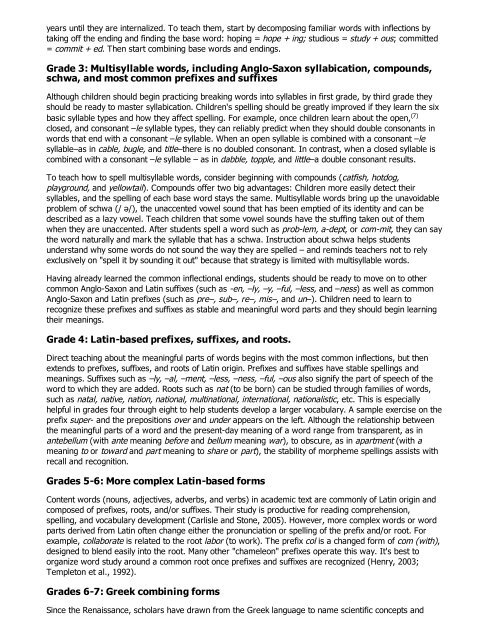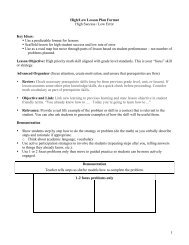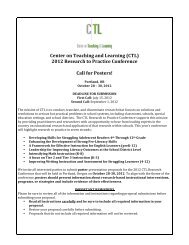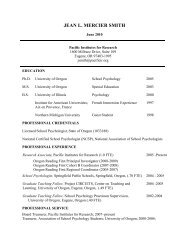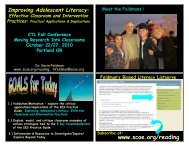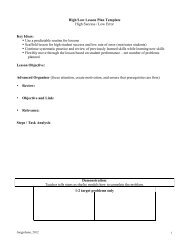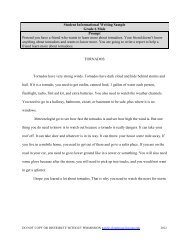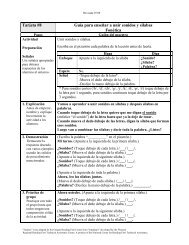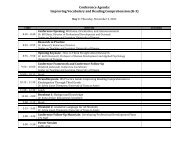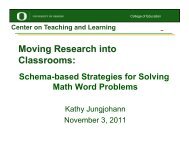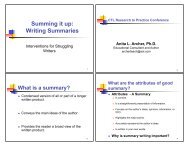How Spelling Supports Reading - Center on Teaching and Learning
How Spelling Supports Reading - Center on Teaching and Learning
How Spelling Supports Reading - Center on Teaching and Learning
You also want an ePaper? Increase the reach of your titles
YUMPU automatically turns print PDFs into web optimized ePapers that Google loves.
years until they are internalized. To teach them, start by decomposing familiar words with inflecti<strong>on</strong>s bytaking off the ending <strong>and</strong> finding the base word: hoping = hope + ing; studious = study + ous; committed= commit + ed. Then start combining base words <strong>and</strong> endings.Grade 3: Multisyllable words, including Anglo-Sax<strong>on</strong> syllabicati<strong>on</strong>, compounds,schwa, <strong>and</strong> most comm<strong>on</strong> prefixes <strong>and</strong> suffixesAlthough children should begin practicing breaking words into syllables in first grade, by third grade theyshould be ready to master syllabicati<strong>on</strong>. Children's spelling should be greatly improved if they learn the sixbasic syllable types <strong>and</strong> how they affect spelling. For example, <strong>on</strong>ce children learn about the open, (7)closed, <strong>and</strong> c<strong>on</strong>s<strong>on</strong>ant –le syllable types, they can reliably predict when they should double c<strong>on</strong>s<strong>on</strong>ants inwords that end with a c<strong>on</strong>s<strong>on</strong>ant –le syllable. When an open syllable is combined with a c<strong>on</strong>s<strong>on</strong>ant –lesyllable–as in cable, bugle, <strong>and</strong> title–there is no doubled c<strong>on</strong>s<strong>on</strong>ant. In c<strong>on</strong>trast, when a closed syllable iscombined with a c<strong>on</strong>s<strong>on</strong>ant –le syllable – as in dabble, topple, <strong>and</strong> little–a double c<strong>on</strong>s<strong>on</strong>ant results.To teach how to spell multisyllable words, c<strong>on</strong>sider beginning with compounds (catfish, hotdog,playground, <strong>and</strong> yellowtail). Compounds offer two big advantages: Children more easily detect theirsyllables, <strong>and</strong> the spelling of each base word stays the same. Multisyllable words bring up the unavoidableproblem of schwa (/ !/), the unaccented vowel sound that has been emptied of its identity <strong>and</strong> can bedescribed as a lazy vowel. Teach children that some vowel sounds have the stuffing taken out of themwhen they are unaccented. After students spell a word such as prob-lem, a-dept, or com-mit, they can saythe word naturally <strong>and</strong> mark the syllable that has a schwa. Instructi<strong>on</strong> about schwa helps studentsunderst<strong>and</strong> why some words do not sound the way they are spelled – <strong>and</strong> reminds teachers not to relyexclusively <strong>on</strong> "spell it by sounding it out" because that strategy is limited with multisyllable words.Having already learned the comm<strong>on</strong> inflecti<strong>on</strong>al endings, students should be ready to move <strong>on</strong> to othercomm<strong>on</strong> Anglo-Sax<strong>on</strong> <strong>and</strong> Latin suffixes (such as -en, –ly, –y, –ful, –less, <strong>and</strong> –ness) as well as comm<strong>on</strong>Anglo-Sax<strong>on</strong> <strong>and</strong> Latin prefixes (such as pre–, sub–, re–, mis–, <strong>and</strong> un–). Children need to learn torecognize these prefixes <strong>and</strong> suffixes as stable <strong>and</strong> meaningful word parts <strong>and</strong> they should begin learningtheir meanings.Grade 4: Latin-based prefixes, suffixes, <strong>and</strong> roots.Direct teaching about the meaningful parts of words begins with the most comm<strong>on</strong> inflecti<strong>on</strong>s, but thenextends to prefixes, suffixes, <strong>and</strong> roots of Latin origin. Prefixes <strong>and</strong> suffixes have stable spellings <strong>and</strong>meanings. Suffixes such as –ly, –al, –ment, –less, –ness, –ful, –ous also signify the part of speech of theword to which they are added. Roots such as nat (to be born) can be studied through families of words,such as natal, native, nati<strong>on</strong>, nati<strong>on</strong>al, multinati<strong>on</strong>al, internati<strong>on</strong>al, nati<strong>on</strong>alistic, etc. This is especiallyhelpful in grades four through eight to help students develop a larger vocabulary. A sample exercise <strong>on</strong> theprefix super- <strong>and</strong> the prepositi<strong>on</strong>s over <strong>and</strong> under appears <strong>on</strong> the left. Although the relati<strong>on</strong>ship betweenthe meaningful parts of a word <strong>and</strong> the present-day meaning of a word range from transparent, as inantebellum (with ante meaning before <strong>and</strong> bellum meaning war), to obscure, as in apartment (with ameaning to or toward <strong>and</strong> part meaning to share or part), the stability of morpheme spellings assists withrecall <strong>and</strong> recogniti<strong>on</strong>.Grades 5-6: More complex Latin-based formsC<strong>on</strong>tent words (nouns, adjectives, adverbs, <strong>and</strong> verbs) in academic text are comm<strong>on</strong>ly of Latin origin <strong>and</strong>composed of prefixes, roots, <strong>and</strong>/or suffixes. Their study is productive for reading comprehensi<strong>on</strong>,spelling, <strong>and</strong> vocabulary development (Carlisle <strong>and</strong> St<strong>on</strong>e, 2005). <str<strong>on</strong>g>How</str<strong>on</strong>g>ever, more complex words or wordparts derived from Latin often change either the pr<strong>on</strong>unciati<strong>on</strong> or spelling of the prefix <strong>and</strong>/or root. Forexample, collaborate is related to the root labor (to work). The prefix col is a changed form of com (with),designed to blend easily into the root. Many other "chamele<strong>on</strong>" prefixes operate this way. It's best toorganize word study around a comm<strong>on</strong> root <strong>on</strong>ce prefixes <strong>and</strong> suffixes are recognized (Henry, 2003;Templet<strong>on</strong> et al., 1992).Grades 6-7: Greek combining formsSince the Renaissance, scholars have drawn from the Greek language to name scientific c<strong>on</strong>cepts <strong>and</strong>


